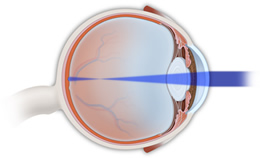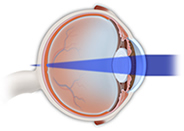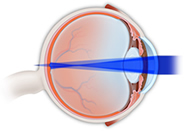The most common eye conditions diagnosed during an eye exam involve refractive errors that cause blurry vision for patients. These conditions affect millions of people in the United States and often get progressively worse as patients age. Fortunately, refractive errors can be easily treated to let patients enjoy clear vision at all distances.
What is Myopia?
Myopia, also known as nearsightedness or shortsightedness, is a condition of the eyes in which nearby objects are clear and distant objects appear blurry. Almost a third of people in the United States experience some degree of nearsightedness.

What is Hyperopia?
Hyperopia, also known as farsightedness, is a condition of the eyes where the focus on distant objects is better than the focus on objects closer to the eye, so nearby objects appear blurry. The eye is designed to focus images directly on the surface of the retina; with hyperopia, light rays focus behind the surface of the retina, producing a blurry image.

What is Astigmatism?
Astigmatism occurs when the cornea - the clear covering over the eye - is slightly irregular in shape, preventing light from focusing properly on the retina in the back of the eye. With astigmatism some of that light focuses either in front of or behind the retina, resulting in vision that may be blurry for either near or far vision or, in some patients, for all objects.

What is Presbyopia?
Presbyopia is a visual inability of the lens of the eye to focus on objects that are close. It occurs when the crystalline lens of the eye loses its flexibility, causing objects to appear blurry. Symptoms may take years to develop and patients begin to show signs of presbyopia in their early- to mid-40s - even in patients who have had laser vision correction. Presbyopia is not a condition that can be cured.
